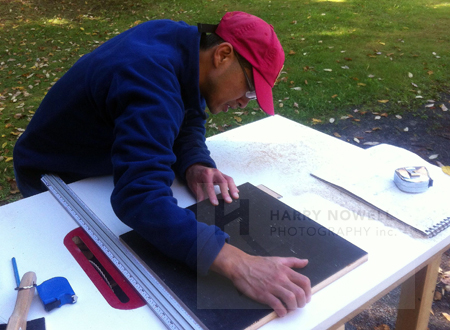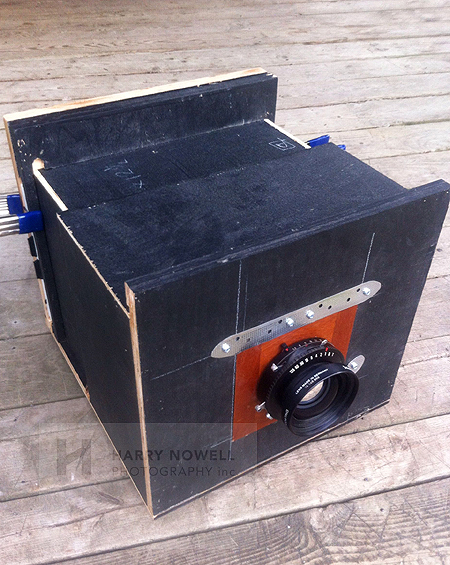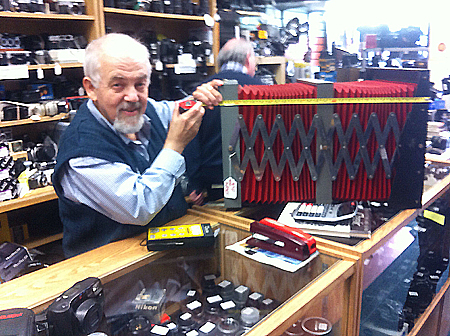A long while back I talked about using ‘small’ large format cameras.
A shorter while back I talked about building a bigger large format camera.
Well, it’s almost done.
All I need are a few bits to allow it to mount onto a mega tripod (thanks Jim) and a couple of other holes drilled to keep the back pieces aligned around the ground glass and film holder.

Building the large format camera – thanks, John, for your help.
Thanks…
A big, BIG thanks go to my distant neighbour John who helped make production as precise as it needed to be. What I thought may take an hour or two turned into 10 hours of design modification, precision cutting, routing, gluing and clamping.
Buying a new or used Large Format Camera would’ve been easier, way more expensive but less rewarding.
So what’s my fascination with Large Format Film?
• It’s big.
Full Frame SLR covers about 1.5 square inches of film/sensor space. A Graflex (lovely camera) covers 20 square inches of film. My new camera covers 80 square inches of loveliness.
‘Big’ helps you print big, very well, but it also has a lovely tactile feel to it. Looking at big slides/negs lets you see something you don’t get on a monitor or under a loupe.

Large format camera 8×10 hand made
• It’s slow.
That’s a good thing in some cases. The process forces you to slow down and get it right.
Modern photojournalist-based cameras boast a firing of speed of 11 frames per second. An 8×10 camera could get you 2 frames a minute if you’re FAST.
I’ve been experimenting with one process and I was getting one frame every 2-10 hours. It makes you think your shot through when a mistake costs you a whole day.
Ahem, last week, on a test shot, I forgot to take the dark slide out (equivalent of the lens cap.) Oops, that wasted a three hour almost-exposure.
And at $25 for film and processing one sheet of E6 film (a traditional slide) you want to make sure you’ve set the camera correctly! There’s not much room for winging it.
• There are no upgrades, obsolescence or menu screens.
I love my DSLR.
I do.
But there are many, many variables, menus and choices.
When I bought it (Nikon D800) the file sizes bogged my laptop computer’s speed. Photoshop and Lightroom needed updates to support the new camera’s raw files and my data crunching machine (Mac tower) needed a newer operating system to operate the software upgrades. Sigh, the dear Mac tower couldn’t run the new OS…
One camera purchase created a huge technology domino effect in my office.

Tom from the CameraTradingCompany.com. Big Camera
• Low Tech
With the large format camera there’s one piece of film, a focusing screen, one lens, a shutter to set and an aperture to decide upon.
• There are no upgrades, ever.
It’s simple, mechanical genius. In school, I was never excited about science but this camera has had me excited about focus theory, flange distances and chemical properties related to Caffenol and UV light. Mr Deussing wouldn’t know what to make of me.
The simplicity is refreshing…
Who Used / Uses Large Format Cameras?
Yousuf Karsh
Ansel Adams
Richard Avedon
Weegee
And even current photographers:
Edward Burtinsky
Andreas Gursky (whose photos sell for $millions!)
Tom from the CameraTradingCompany.com
Stay tuned….
